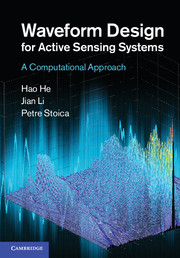Book contents
- Frontmatter
- Contents
- Preface
- Notation
- Abbreviations
- 1 Introduction
- Part I Aperiodic correlation synthesis
- Part II Periodic correlation synthesis
- Part III Transmit beampattern synthesis
- Part IV Diverse application examples
- 16 Radar range and range–Doppler imaging
- 17 Ultrasound system for hyperthermia treatment of breast cancer
- 18 Covert underwater acoustic communications – coherent scheme
- 19 Covert underwater acoustic communications – noncoherent scheme
- References
- Index
18 - Covert underwater acoustic communications – coherent scheme
from Part IV - Diverse application examples
Published online by Cambridge University Press: 05 August 2012
- Frontmatter
- Contents
- Preface
- Notation
- Abbreviations
- 1 Introduction
- Part I Aperiodic correlation synthesis
- Part II Periodic correlation synthesis
- Part III Transmit beampattern synthesis
- Part IV Diverse application examples
- 16 Radar range and range–Doppler imaging
- 17 Ultrasound system for hyperthermia treatment of breast cancer
- 18 Covert underwater acoustic communications – coherent scheme
- 19 Covert underwater acoustic communications – noncoherent scheme
- References
- Index
Summary
Achieving reliable communication over underwater acoustic (UWA) channels is a challenging problem owing to the scarce bandwidth available and the double spreading phenomenon, i.e., spreading in both time (multipath delay spread) and frequency domains (Doppler spread) [Kilfoyle & Baggeroer 2000]. Delay and Doppler spreading is inherent to many practical communication channels, but are considerably amplified in UWA environments [Stojanovic et al. 1994]. Double spreading complicates the receiver structure and makes it difficult to extract the desired symbols from the received signals.
Telemetry systems adopting direct-sequence spread-spectrum (DSSS) based modulation techniques are conventionally referred to as operating at low data rates. Existing literature regarding low data rate UWA communications include [Palmese et al. 2007][Stojanovic et al. 1998][Hursky et al. 2006][Yang & Yang 2008][Stojanovic & Freitag 2000][Blackmon et al. 2002][Ritcey & Griep 1995][Stojanovic & Freitag 2004][Sozer et al. 1999][Tsimenidis et al. 2001][Iltis & Fuxjaeger 1991]. By sacrificing the data rate, DSSS techniques exploit frequency diversity in the frequency-selective UWA channel and benefit from spreading gain to allow many co-channel users. At the receiver side, decentralized reception schemes encompass nonlinear equalization including hypothesis-feedback equalization [Stojanovic & Freitag 2000], and linear equalization including RAKE receivers [Tse & Viswanath 2005]. Performance comparisons of hypothesis-feedback equalization and RAKE reception are presented in [Blackmon et al. 2002].
In this chapter, we consider a single user scenario with a coherent RAKE reception scheme (the noncoherent schemes, which do not require a channel estimation, will be discussed in Chapter 19).
Information
- Type
- Chapter
- Information
- Waveform Design for Active Sensing SystemsA Computational Approach, pp. 267 - 279Publisher: Cambridge University PressPrint publication year: 2012
